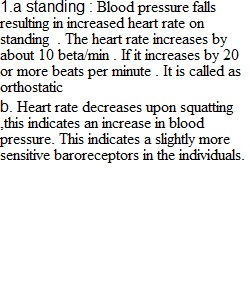


Q 1. How much and in which direction (increase or decrease) did the heart rate change as a result of a. standing? b. squatting? 2. Changing the heart rate is only one of a variety of homeostatic mechanisms that maintain a fairly constant blood pressure during changes in body position. The sympathetic nervous system helps by adjusting peripheral resistance in the arterial system. As this occurs the heart rate is able to normalize again. Compare the response time to the recovery time. What does your data tell you about the relative speed of the change in peripheral vascular resistance as compared to that of the heart rate response? 3. Dizziness may result from low blood pressure and can occur in patients who take medicines which impair the ability of the heart to increase its rate. Given what you have learned from your data, which daily activities would be most likely to cause dizziness in people who take these medications?
View Related Questions